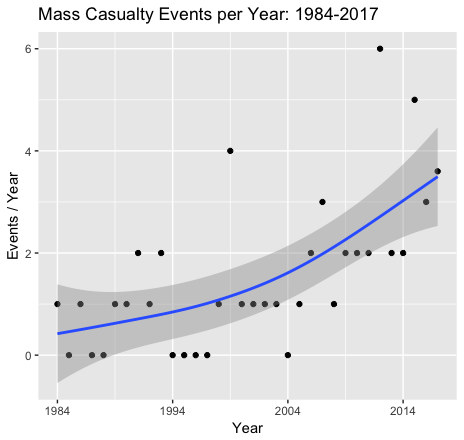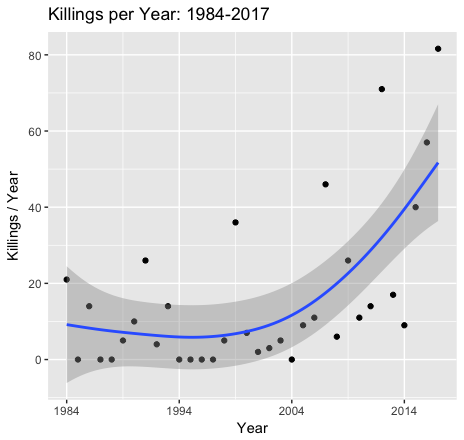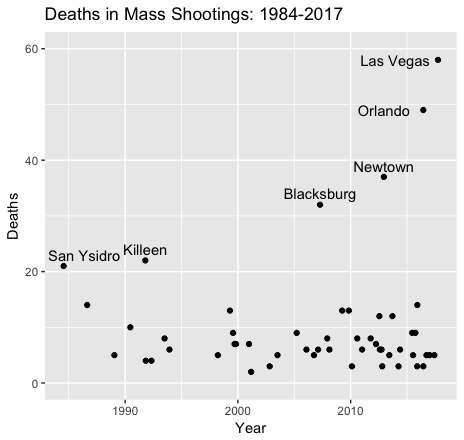Every so often, an American shoots a large group of strangers in a public setting, and then is shot or, more often, shoots himself. The effect of these events on American gun policy has been surprising. Ross Douthat observed that
We… keep having a debate over guns in the United States; it’s just that the side that’s convinced that new regulations will prevent another Newtown or Orlando or Las Vegas keeps on losing the argument.
Douthat is absolutely right about which side has been losing. In the last decade, regulations on the sale, ownership, and carrying of firearms in the US have been reduced, not increased. It’s open to question, however, how long this can continue.
The LA Times has a list of shootings of five or more people since 1984. By their count, there have been 52 such events, accounting for 537 deaths, in the 34 years since 1984. This is about 15 deaths per year, which is 0.04% of the 34,000 annual American firearms deaths. The likelihood of dying in a mass shooting is about one-third that of dying by lightning strike and about one-sixth that of dying in a flood. Americans are killed by guns primarily through accidents, ‘non-mass’ homicides, and suicides, not mass shootings.
Having noted this, the frequency of mass shootings per year is increasing (equivalently, the time from one mass shooting to the next is decreasing).

There were 9 mass shootings in the 10 years from 1984 to 1993 compared to 28 from 2008 until today. The annual death toll has also been rising, even faster than the increase in the number of mass shootings. There were 94 deaths from 1984 to 1993 compared to 319 from 2008 until today.

If you look at a scatter plot that includes all 52 events, there appear to be two classes of mass shootings.

There has been a profusion of shootings involving 5 to 19 deaths at the bottom of the graph. Above that is a series of ultra casualty events (which I have labelled by the city in which they occurred). The death rate in these massacres has almost tripled since 2000.
Why is the scale of the extreme events increasing? One reason is technology. Modern small arms are highly lethal, portable, and affordable. Lethality is a combination of a weapon’s rate of fire, magazine capacity, accurate range, and the trauma inflicted by light-weight high-velocity rounds. Modern weapons are so effective that a single armed man targeting a crowd can inflict casualty rates that are reminiscent of the Battle of the Somme, rather than a bar fight. The editors of the New England Journal of Medicine comment that:
readily available high-powered modern weaponry makes mass killing easy for a determined killer, even an inexperienced one. [In Las Vegas], the magnitude of the killing could have been far greater. Given his position and his firepower, the shooter could have killed thousands…
I doubt that the Las Vegas shooter could have killed thousands, but I am certain that the effectiveness of small arms will continue to improve. Current arms automate most of the loading of firearms, but foreseeable technology will also automate their aiming and facilitate their remote operation. If no limits are set on civilian access to continuously improving weapons technology, we should expect to see massacres with 100s of deaths.
I do not want to predict that Americas will eventually act to reduce civilian access to highly lethal small arms. As Douthat noted, that prediction loses. But on current trends, it is not clear what the alternatives are. We do not know how to predict who will commit mass murder. There are handwaving discussions about improving mental health care, which might help at the margin, except that no one is actually serious about implementing improved care.
The industrial revolution forced the military to abandon mass formations. Infantrymen are now camouflaged, armoured, and above all dispersed. Life in cities — and civilian life generally — involves people gathering in public spaces. At some point, continued increases in the frequency and scale of mass shootings become incompatible with ordinary civic life.
